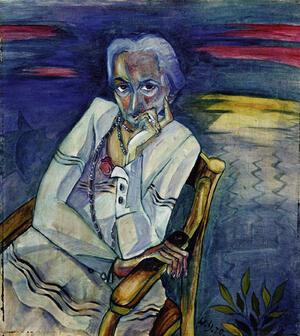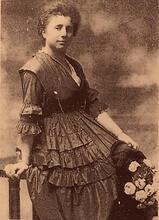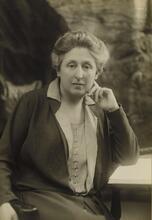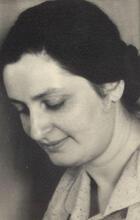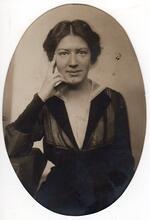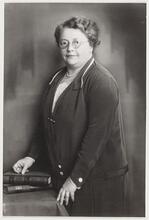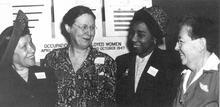Rosa Schapire
Rosa Schapire used her ground-breaking career in art history to advocate for socialist, feminist, and anti-fascist ideals across Europe in the twentieth century. Her family and education in her hometown of Galicia, Poland, introduced her to such ideals, and her studies took her around Europe. Schapire’s contributions to the art world were many, ranging from reviews and critiques to translations to amassing an impressive collection of German Expressionist work. She edited several journals and, along with fellow art patron and suffragette Ida Dehmel, helped to form the Women’s Society for the Advancement of German Art. After the rise of the Nazis and the death of many family members, Schapire fled to England, where many pieces of her collection are still housed in museums.
Early Life, Education, and Family
Born into a wealthy Jewish family in Brody, Galicia, in Poland in 1874, Rosa Schapire was the second youngest of five daughters. Though there is little information on her parents, the town was well known for its vigorous Jewish life, dominated by Hasidic and Orthodox traditions. Interestingly, in much later correspondence with her colleague Agnes Holthusen (January 10, 1948), Schapire recalled her childhood memories of the nationalistic and religious divisions between the Poles and the Ruthenians (Ukranians) in Galicia, which was part of the Habsburg Empire. Here she declared that she was predestined towards internationalism through her birth, upbringing, and fate. It would seem that she regarded her Jewish origins in a positive light, as securing her freedom from considerations of national identity.
Schapire’s aptitude for languages and her secular educational background enabled her to move beyond the bounds of the area. As she explained in a short biography that was appended to her doctoral thesis, due to the lack of appropriate schooling in Brody she was educated at home (Schapire 1904, 49). She states, moreover, that she immigrated to Hamburg in 1893 and that her interest in art history was kindled in programs initiated by the local museum directors Justus Brinkmann and Alfred Lichtwark. As with other regional centers during the Wilhelmine period, this mercantile Hanseatic city was in the process of forging a sense of modern identity by mobilizing public institutions, traditions, and culture.
Schapire’s parents evidently provided their daughters with an enlightened, cosmopolitan, and rich cultural milieu that encouraged their independence. Rosa’s younger sister Anna (1877–1911), who studied in Vienna and Berlin, was also a high achiever, graduating in 1906 with a Ph.D. in Economics from Bern University. Like Rosa, Anna was a gifted linguist, translating literature from Russian, Polish, French, and English into German. She was also thoroughly committed to socialist and feminist causes. In 1907 she married her colleague, the social scientist Otto Neurath (1882–1945), and they enjoyed a fruitful academic collaboration until her untimely death in childbirth, her son Paul surviving her.
Forging a Path for Women in the Arts
Rosa was one of the few women to pursue art history studies at a time when the discipline itself was still in its infancy. However, she was no mere dilettante. and her foray into this male-dominated profession was indicative of her allegiance to feminist aspirations to equal opportunity and adult suffrage. Indeed, in 1897, one of her first publications, entitled “Ein Wort zur Frauenemanzipation” (A word on women’s emancipation), was devoted to the theme of sexual politics. Fiercely anti-capitalist, Schapire promoted socialism as the remedy to the so-called “women’s question” (Schapire 1897, 511). It was only in such a state, she continued, that it was possible for both sexes to become comrades in confronting the future (Schapire 1897, 517). Schapire, who never married, retained a strong commitment to socialist utopianism, one that was founded upon intellectual and artistic endeavor.
In 1902, Schapire pursued her undergraduate degree at Bern University and by 1904 had gained her Ph.D. under the supervision of Henry Thode at the university in Heidelberg. Thereafter, she spent a semester studying under Heinrich Wölfflin in Berlin and, in 1905, a further year at Leipzig University. She travelled extensively and resettled in Hamburg in 1908. There, Schapire played an active role in the art scene as a lecturer, reviewer, critic, editor, and translator. Though her thesis was devoted to the eighteenth-century Frankfurt landscapist Johann Morgenstern, she began promoting contemporary German art. Through her contact with the district judge and collector Gustav Schiefler and the circle of women grouped around the Frauenclub (Women’s Club), Schapire was recruited as a “passives Mitglied” (passive member) by the Dresden-based group of Expressionists known as the Brücke (Bridge). She was particularly drawn to the works of Karl Schmidt-Rottluff, later commissioning him to design furniture and applied art for her apartment in Osterbekstraße and publishing a catalogue raisonné of his graphic works in 1924.
While the enlightenment concept of Bildung (cultivation or education) was at the core of Schapire’s pursuit of an inward culture, her public activities assumed national dimensions during the World War I. In 1916, along with the patron and suffragette Ida Dehmel, Schapire spearheaded the formation of the Frauenbund zur Förderung deutscher bildenden Kunst (Women’s Society for the Advancement of German Art). Due to the privations of war and a reduction in purchasing budgets of official galleries and museums, Schapire considered it necessary for the Frauenbund to sponsor exhibitions and to donate contemporary art as gifts to the state. Thereby the Nietzschean ideal of cultural renewal could be achieved through constant reference to a living, creative tradition (Schapire 1919, 167). In the media explosion of the early Weimar period, she acted as co-editor of and contributor to two Expressionist journals, Die Rote Erde (The Red Earth) and Kündung (Herald). Her contact with artists expanded to include the Hamburg Secessionists, Walter Gramatté, Franz Radziwill, and Rolf Nesch. Understandably, then, she was acclaimed by Hans Fischer as “an untiring recruiter for new art” (Fischer 1923, 225).
Flight and Resistance during the Nazi Years
In 1933, with the Nazi accession to power, Schapire’s career suffered a tremendous setback; by that time, her publications amounted to almost two hundred items, ranging from art historical book reviews and learned articles to translations into German of Balzac and Zola, but it was not until 1947 in England that she resumed her writing. On January 22, 1939, she was compelled to write an “SOS call” to Fritz Saxl, Director of the Warburg Institute in London. With his sponsorship she was able to flee Germany in August, just two weeks before the outbreak of war. In her correspondence with Holthusen, Schapire occasionally provides glimpses of her private persona, revealing a profound disillusionment and philosophical questioning over the tragedy of the Holocaust. While her parents and two of her sisters had died of natural causes, her older sibling Gertrud perished as a result of incarceration in Theresienstadt, and her nephew, Paul Neurath, immigrated to New York after surviving fourteen months in Dachau and Buchenwald (June 24, 1949; August 14, 1949). Notwithstanding her existential trauma, Schapire found a spiritual and intellectual refuge in British academic life, however marginalized her position. During 1945 she conducted research for her former brother-in-law Otto Neurath, Director of the Oxford Institute, and, through her contact with the émigré architectural historian Nikolaus Pevsner (1902–1983), became involved in securing material for his long-term project on The Buildings of England for the publisher Penguin. From 1947 onwards she earned a modest income by resuming journal publications in English and German, contributing to the Architectural Review, Eidos, and Connoisseur and acting as a correspondent from London and book reviewer for Die Weltkunst.
As she learnt more about the criminal destruction of “Degenerate Art,” Schapire’s promotion of German Expressionist art was transformed into a political struggle against Fascism. In 1946 she offered part of her collection to the Tate Gallery, writing to the director Sir John Rothenstein that the gift of these works was intended “as a token of my gratitude for the hospitality that I found in your country” (August 23, 1946). Sadly, the issues of her bequest were not resolved until after her death in 1954, three paintings and a sculptural piece by Schmidt-Rottluff finding their way into the Tate. Since the offer in 1950 of her complete collection of graphics and works on paper to the British Museum Department of Prints and Drawings was rejected, these were dispersed among various museums in Germany, Holland, Belgium, Chicago and Tel Aviv, with representative examples remaining in the Victoria and Albert and Leicestershire Museums in Britain. Yet this bequest contributed to a pattern of reception of twentieth-century German art in Britain and facilitated the recuperation of Schapire’s seminal role as patron, collector and critic in early twentieth-century German Expressionism.
Selected Works
Correspondence. Nachlaß Agnes Holthusen. Archiv für Bildende Kunst, Germanisches Nationalmuseum Nürnberg.
Correspondence. Tate Gallery Archive, London
Correspondence. Warburg Institute Archive, London
“Ein Wort zur Frauenemanzipation” (A word on women’s emancipation). Sozialistische Monatshefte 1 (1987): 510–517.
Der Frankfurter Maler Johann Ludwig Ernst Morgenstern 1738–1819. Ruprecht-Karls-Universität zu Heidelberg: 1904.
“Der Frauenbund zur Förderung deutscher bildenden Kunst” (The Women’s Society for the Advancement of German Art). Neue Blätter für Kunst und Dichtung 2 (November 1919): 166–167.
Karl Schmidt-Rottluffs Graphisches Werk. Berlin: Euphorion Verlag, 1924.
Review of Kunstdiktatur im Dritten Reich by Paul Ortwin Rave (Frankfurt am Main: Bücherglide Gutenberg, 1949). Eidos 2 (1950): 47–48.
Behr, Shulamith. “Anatomy of the woman as collector and dealer in the Weimar period: Rosa Schapire and Johanna Ey.” In Visions of the “Neue Frau”: Women and the Visual Arts in Weimar Germany, edited by Marsha Meskimmon and Shearer West, 96–107. Aldershot: Scolar Press, 1995.
Behr, Shulamith. “Supporters and Collectors of Expressionism.” In German Expressionism: Art and Society, edited by Stephanie Barron and Wolf-Dieter Dube, 45–58. New York: Rizzoli, 1997.
Behr, Shulamith. “Dr Rosa Schapire – Art Historian and Critic in Exile.” In Keine Klage über England? Deutsche und österreichische Exilerfahrungen in Großbritannien 1933–1945 (No Complaints about England? German and Austria Experiences in Great Britain 1933-1945), edited by Charmian Brinson, Richard Dove, Anthony Grenville, Marian Malet and Jennifer Taylor, 215–223. Munich: ludicum, 1998.
Bruhns, Maike. “Rosa Schapire und der Frauenbund zur Förderung deutscher bildenden Kunst” (Rosa Schapire and the Women’s Society for the Advancement of German Art), In Avantgarde und Publikum: Zur Rezeption avant-gardistischer Kunst in Deutschland 1905–1933 (Avant-garde and Audience: On the Reception of Avant-garde Art in Germany 1905-1933), edited by Henrike Junge, 269-282. Cologne: Böhlau, 1992.
Fischer, Hans. Hamburger Kulturbilderbogen. Munich: Rosi, 1923
Matz, Cornelie. “Die Organisationsgeschichte der Künstlerinnen in Deutschland von 1867 bis 1933” (The Organizational History of Women Artists in Germany from 1867 to 1933). Ph.D. diss., Eberhard-Karls-Universität Tübingen: 2001.
Presler, Gerd. “Brücke” an Dr. Rosa Schapire. Mannheim: Städtische Kunsthalle, 1990.
Wietek, Gerhard. “Dr phil Rosa Schapire.” Jahrbuch der Hamburger Kunstsammlungen 9 (1964): 115–160.

